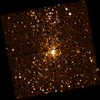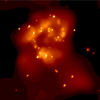CXC Home | Search | Help | Image Use Policy | Latest Images | Privacy | Accessibility | Glossary | Q&A
Q:
How are stars formed?
A:
Understanding how stars are formed has proved to be a difficult task. One reason for this is that stars are born in the dark, inside huge clouds of dust and gas. These clouds obscure the view of optical wavelength telescopes until the new star’s radiation can clear out a region around it. Infrared and radio waves can pass through the dense clouds of dust and gas, so the development of powerful infrared and radio telescopes has led to greatly improved understanding of the star forming
What we know is this:
- Stars form in huge clouds of molecules and dust, called Giant Molecular Clouds (GMC). These clouds can range from tens to hundreds of light years in diameter and contain enough material to make thousands to millions of stars.
- Stars don’t form alone but in clumps or clusters of dozens to thousands of stars when a portion of the GMC is compressed, increasing its gravity and causing it to collapse.
- As it collapses, the large fragment breaks up into smaller fragments which eventually become individual stars. Observations show that the birth weight of stars can range from a few percent to 50 times the mass of the Sun.
- It is not known for certain what causes the initial compression of a GMC fragment. There is evidence that shock waves play a role. These shocks could come from a supernova explosion, or fierce winds blowing from a cluster of newborn stars, or from a collision of the entire galaxy with another galaxy. See Starburst Galaxies




